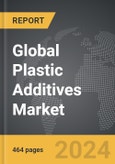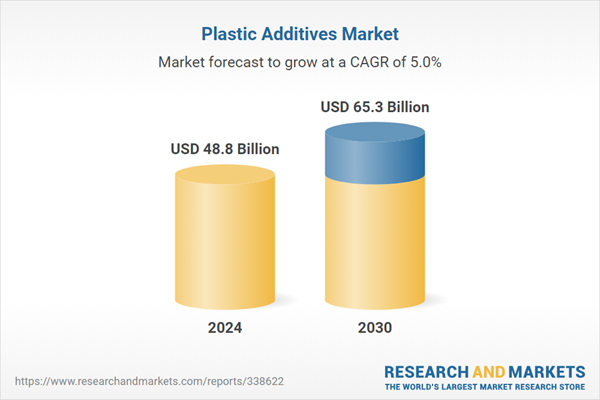The global market for Plastic Additives was valued at US$48.8 Billion in 2024 and is projected to reach US$65.3 Billion by 2030, growing at a CAGR of 5.0% from 2024 to 2030. This comprehensive report provides an in-depth analysis of market trends, drivers, and forecasts, helping you make informed business decisions. The report includes the most recent global tariff developments and how they impact the Plastic Additives market.
Segments: Plastic Type (Commodity Plastic, Engineering Plastic, High Performance Plastic); Product Type (Plasticizers, Stabilizers, Flame Retardants, Impact Modifiers, Other Product Types); End-Use (Construction, Packaging, Consumer Goods, Automotive, Other End-Uses).
Geographic Regions/Countries: World; United States; Canada; Japan; China; Europe (France; Germany; Italy; United Kingdom; Spain; Russia; and Rest of Europe); Asia-Pacific (Australia; India; South Korea; and Rest of Asia-Pacific); Latin America (Argentina; Brazil; Mexico; and Rest of Latin America); Middle East (Iran; Israel; Saudi Arabia; United Arab Emirates; and Rest of Middle East); and Africa.
The analysts continuously track trade developments worldwide, drawing insights from leading global economists and over 200 industry and policy institutions, including think tanks, trade organizations, and national economic advisory bodies. This intelligence is integrated into forecasting models to provide timely, data-driven analysis of emerging risks and opportunities.
Global Plastic Additives Market - Key Trends & Drivers Summarized
Why Are Plastic Additives Critical in Modern Manufacturing?
Plastic additives are essential components in the manufacturing of plastic products, enhancing their properties and performance. These additives, which include stabilizers, plasticizers, flame retardants, and antioxidants, improve the durability, flexibility, and safety of plastics. Stabilizers prevent degradation caused by heat and UV radiation, while plasticizers increase flexibility and workability. Flame retardants enhance fire resistance, and antioxidants prevent oxidation and extend the lifespan of plastics. The use of plastic additives ensures that plastic products meet the specific requirements of various applications, from automotive parts and construction materials to consumer goods and electronics.How Have Technological Innovations Enhanced Plastic Additives Production and Applications?
Technological advancements have significantly improved the production and applications of plastic additives. Innovations in chemical synthesis and formulation have led to the development of high-performance additives with enhanced effectiveness and environmental sustainability. The introduction of nanotechnology has enabled the creation of nano-additives that provide superior performance characteristics, such as increased strength and thermal stability. Additionally, the development of bio-based and non-toxic additives is gaining traction, driven by stringent environmental regulations and consumer demand for sustainable products. These technological strides have expanded the scope and utility of plastic additives, driving their demand across various industries.What Are the Emerging Trends in Plastic Additives Consumption?
Emerging trends in plastic additives consumption reflect evolving industry demands and sustainability goals. The growing focus on sustainability is driving the demand for bio-based and environmentally friendly additives. In the automotive and construction industries, there is an increasing need for high-performance additives that enhance the durability, strength, and safety of plastic components. The packaging industry is witnessing a rise in the use of additives that improve the barrier properties and recyclability of plastic packaging. Additionally, the electronics sector is increasingly using additives that provide thermal stability and flame resistance to plastic components. These trends highlight the diverse applications and evolving consumption patterns of plastic additives.What Factors Are Driving the Growth in the Plastic Additives Market?
The growth in the plastic additives market is driven by several factors. Firstly, the rising demand for high-performance plastics in automotive, construction, and packaging industries is propelling the use of plastic additives. Secondly, the expanding focus on sustainability and the development of bio-based and environmentally friendly additives are significant growth drivers. The increasing use of plastics in electronics and the need for additives that provide thermal stability and flame resistance are also contributing to market growth. Additionally, the continuous development of advanced additives with superior performance characteristics is enhancing their applications, fueling market expansion. The growing consumer preference for durable and high-quality plastic products further drives market growth. Lastly, ongoing research and development efforts aimed at discovering new applications and improving additive formulations continue to foster market growth, underscoring the robust growth trajectory of the plastic additives market.Report Scope
The report analyzes the Plastic Additives market, presented in terms of units. The analysis covers the key segments and geographic regions outlined below.Segments: Plastic Type (Commodity Plastic, Engineering Plastic, High Performance Plastic); Product Type (Plasticizers, Stabilizers, Flame Retardants, Impact Modifiers, Other Product Types); End-Use (Construction, Packaging, Consumer Goods, Automotive, Other End-Uses).
Geographic Regions/Countries: World; United States; Canada; Japan; China; Europe (France; Germany; Italy; United Kingdom; Spain; Russia; and Rest of Europe); Asia-Pacific (Australia; India; South Korea; and Rest of Asia-Pacific); Latin America (Argentina; Brazil; Mexico; and Rest of Latin America); Middle East (Iran; Israel; Saudi Arabia; United Arab Emirates; and Rest of Middle East); and Africa.
Key Insights:
- Market Growth: Understand the significant growth trajectory of the Commodity Plastic segment, which is expected to reach US$34.5 Billion by 2030 with a CAGR of a 4.6%. The Engineering Plastic segment is also set to grow at 5.5% CAGR over the analysis period.
- Regional Analysis: Gain insights into the U.S. market, valued at $13.0 Billion in 2024, and China, forecasted to grow at an impressive 8.2% CAGR to reach $14.0 Billion by 2030. Discover growth trends in other key regions, including Japan, Canada, Germany, and the Asia-Pacific.
Why You Should Buy This Report:
- Detailed Market Analysis: Access a thorough analysis of the Global Plastic Additives Market, covering all major geographic regions and market segments.
- Competitive Insights: Get an overview of the competitive landscape, including the market presence of major players across different geographies.
- Future Trends and Drivers: Understand the key trends and drivers shaping the future of the Global Plastic Additives Market.
- Actionable Insights: Benefit from actionable insights that can help you identify new revenue opportunities and make strategic business decisions.
Key Questions Answered:
- How is the Global Plastic Additives Market expected to evolve by 2030?
- What are the main drivers and restraints affecting the market?
- Which market segments will grow the most over the forecast period?
- How will market shares for different regions and segments change by 2030?
- Who are the leading players in the market, and what are their prospects?
Report Features:
- Comprehensive Market Data: Independent analysis of annual sales and market forecasts in US$ Million from 2024 to 2030.
- In-Depth Regional Analysis: Detailed insights into key markets, including the U.S., China, Japan, Canada, Europe, Asia-Pacific, Latin America, Middle East, and Africa.
- Company Profiles: Coverage of players such as BASF SE, Clariant International Ltd., Dow Inc., Evonik Industries AG, Exxon Mobil Corporation and more.
- Complimentary Updates: Receive free report updates for one year to keep you informed of the latest market developments.
Some of the 93 companies featured in this Plastic Additives market report include:
- BASF SE
- Clariant International Ltd.
- Dow Inc.
- Evonik Industries AG
- Exxon Mobil Corporation
- Lanxess AG
- Nabaltec AG
- Nouryon
Tariff Impact Analysis: Key Insights for 2025
Global tariff negotiations across 180+ countries are reshaping supply chains, costs, and competitiveness. This report reflects the latest developments as of April 2025 and incorporates forward-looking insights into the market outlook.The analysts continuously track trade developments worldwide, drawing insights from leading global economists and over 200 industry and policy institutions, including think tanks, trade organizations, and national economic advisory bodies. This intelligence is integrated into forecasting models to provide timely, data-driven analysis of emerging risks and opportunities.
What’s Included in This Edition:
- Tariff-adjusted market forecasts by region and segment
- Analysis of cost and supply chain implications by sourcing and trade exposure
- Strategic insights into geographic shifts
Buyers receive a free July 2025 update with:
- Finalized tariff impacts and new trade agreement effects
- Updated projections reflecting global sourcing and cost shifts
- Expanded country-specific coverage across the industry
Table of Contents
I. METHODOLOGYII. EXECUTIVE SUMMARY2. FOCUS ON SELECT PLAYERSIII. MARKET ANALYSISCANADAITALYSPAINRUSSIAREST OF EUROPESOUTH KOREAREST OF ASIA-PACIFICARGENTINABRAZILMEXICOREST OF LATIN AMERICAIRANISRAELSAUDI ARABIAUNITED ARAB EMIRATESREST OF MIDDLE EASTIV. COMPETITION
1. MARKET OVERVIEW
3. MARKET TRENDS & DRIVERS
4. GLOBAL MARKET PERSPECTIVE
UNITED STATES
JAPAN
CHINA
EUROPE
FRANCE
GERMANY
UNITED KINGDOM
ASIA-PACIFIC
AUSTRALIA
INDIA
LATIN AMERICA
MIDDLE EAST
AFRICA
Companies Mentioned (Partial List)
A selection of companies mentioned in this report includes, but is not limited to:
- BASF SE
- Clariant International Ltd.
- Dow Inc.
- Evonik Industries AG
- Exxon Mobil Corporation
- Lanxess AG
- Nabaltec AG
- Nouryon
Table Information
| Report Attribute | Details |
|---|---|
| No. of Pages | 464 |
| Published | April 2025 |
| Forecast Period | 2024 - 2030 |
| Estimated Market Value ( USD | $ 48.8 Billion |
| Forecasted Market Value ( USD | $ 65.3 Billion |
| Compound Annual Growth Rate | 5.0% |
| Regions Covered | Global |









